Roasting eggplant brings out a whole new dimension to this versatile kitchen staple. In this post I will walk through the best methods for roasting a whole eggplant on a gas range, grill, or in the oven. The techniques each results in smoky, tender eggplant pulp that is full of flavor.
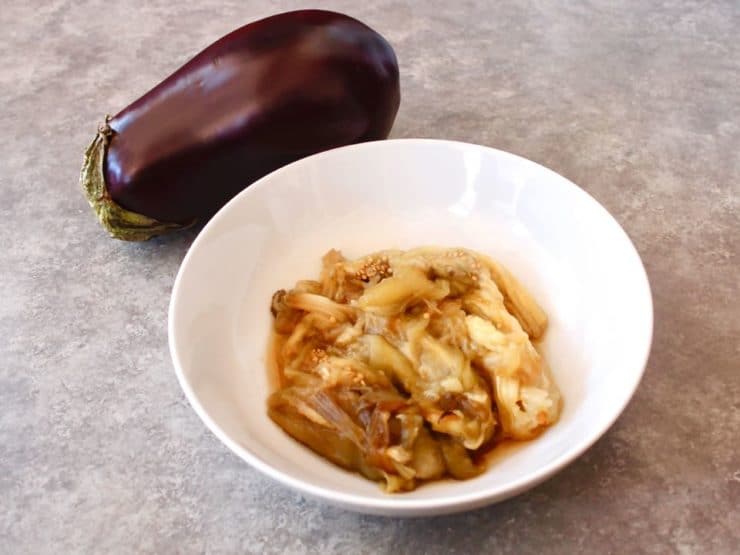
The eggplant, also known as aubergine, has been cultivated in India for over 4,000 years. Eggplant is a fruit– in fact it is technically a large berry, although most cooks generally consider it a vegetable. The oldest surviving mention of the fruit dates back to the 5th century in a Chinese agricultural work called Ts’i Min Yao Shu. It later made its way to Persia in the 4th century CE, where it eventually became firmly rooted as a major part of the Middle Eastern diet.
Eggplant is an affordable, healthy dietary staple that can be prepared in numerous ways. During a second Jewish expulsion from Spain and Portugal in 1580 (when the two countries united under one crown), eggplant became known as the “Jew’s apple” because of its frequent usage in Sephardic Jewish cuisine.
Once you know how to roast an eggplant, there are a number of dishes you can make with it. In this post I will share my favorite methods for roasting eggplant, along with some tips for ensuring a tasty result every time you roast.
Recipe Ideas for Roasted and Charred Eggplant
Eggplant Tahini Basil Crostini
I prefer roasting eggplants on the gas stove or grill. Roasting on an open flame imparts a delicate smoky flavor into the eggplant flesh. If you do not have a gas stove, you can also roast it in the oven. Both methods are described below.
Other Ways to Cook Eggplant
How to Cook Eggplant with Less Oil
Recommended Products:
We are a participant in the Amazon Services LLC Associates Program, an affiliate advertising program designed to provide a means for us to earn fees by linking to Amazon.com and affiliated sites. As an Amazon Associate I earn from qualifying purchases.
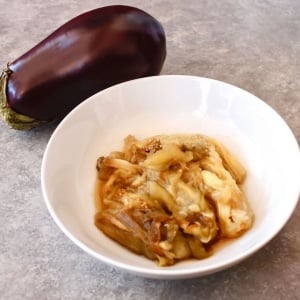
How to Roast Eggplant
Ingredients
- 1 whole eggplant
- 1 tablespoon extra virgin olive oil, as needed
NOTES
Instructions
Roasting Eggplant on a Range (Recommended)
- Wash and dry eggplant. Pierce it a few times with a fork to vent. Important - for any of the cooking methods outlined below, make sure you pierce with a fork-- otherwise you could end up with an exploded eggplant!

- If you have a gas range, you can roast it directly on top of the range. You might wish to protect your gas range burner with a layer of foil, which makes for easier cleanup. The eggplant will weep a bit as it roasts, leaving charred bits and goop on the range.

- Place eggplant directly on top of the gas range grate. On my gas stove, I usually turn the flame to medium.

- Allow eggplant to roast over the flame for 20-30 minutes, giving it a quarter every 5 minutes as it cooks. The larger the eggplant, the longer it will take to roast. Smaller eggplants (like Japanese eggplants) will roast faster. When finished cooking, remove from oven and proceed to "Peeling Your Eggplant."

- If you have an electric range, or if you want to protect your gas range from the mess, you can use a grill pan to roast the eggplant. A grill pan will protect your stove from the drips of roasted eggplant juice. Here is the one I use - Grill Pan.

- Prepare grill pan according to instructions. My pan requires a bit of water to be placed in the circular chamber. Preheat grill pan over medium heat; brush lightly with oil if it is recommended for your pan. Pierce the eggplant a few times to vent, then place on the preheated grill pan.

- Roast the eggplant for 40-50 minutes, giving a quarter turn with a pair of tongs every 5 minutes or so, until the eggplant is charred and collapsing. Check water level about halfway through cooking if your grill pan requires it. When eggplant is tender, charred and collapsing, remove from grill pan and proceed to "Peeling Your Roasted Eggplant."

Roasting on a Grill (Recommended)
- If using a grill, light gas or coals and preheat the grill to medium heat before you begin to roast.

- Allow eggplant to roast over the flame for 20-30 minutes, giving it a quarter every 5 minutes as it cooks. The larger the eggplant, the longer it will take to roast.

- When eggplant is tender and collapsing, remove from grill and proceed to "Peeling Your Roasted Eggplant."

Oven Roasting Method
- Place a rack 8-9 inches beneath your oven's broiler and preheat the broiler. Lightly grease a baking sheet with cooking oil. Wash and dry eggplant, then pierce a few times with a fork to vent. Place on a baking sheet under the broiler and let the eggplant roast for 20-30 minutes, giving a quarter turn every 5-7 minutes.

- Eggplant is finished roasting when it is soft, tender and collapsing. Remove from oven and proceed to "Peeling Your Roasted Eggplant."

Roasting Salted Eggplant Halves
- If you encounter a bitter eggplant, you will want to halve it and salt it prior to cooking. The method for salting is described below. Once salting is complete, this is the way you roast it. Place eggplant halves flesh-side down on a lightly greased baking sheet (so the flat cut side is directly against the baking sheet).

- Roast 8-9 inches underneath the broiler for 20-30 minutes until the eggplant halves are charred and the halves are beginning to collapse. The larger the eggplant, the longer it will take to roast. Smaller eggplants (like Japanese eggplants) will roast faster. Remove from oven. Check the eggplant flesh to make sure it is soft, roasted, and caramelized throughout. If any parts looked light-colored or undercooked, return to the oven to roast for a few minutes longer.

- Scoop out the roasted pulpy flesh from each half and place it in a bowl. Discard the charred skin. There will be some residual smoky juice that collects in the bowl; you can drain it off or blend it into the eggplant, depending on the flavor you want to achieve (see Eggplant Roasting Tips, below).

Peeling Your Roasted Eggplant
- Once the eggplant is very tender and collapsing, remove from heat with tongs and place it on a cutting board. There will be some residual smoky juice that collects on the board; you can drain it off or blend it into the eggplant, depending on the flavor you want to achieve.

- Slice the eggplant open. Scoop out the roasted pulpy flesh and place it in a bowl. Discard the charred skin. The eggplant will be quite soft, and you may need to peel off a few small bits of skin by hand. I'm not super careful about it; I find that a few charred bits actually enhance the smoky flavor, which we find desirable.

- Once the eggplant is separated from the charred skin, you are left with perfectly tender, roasted and smoky eggplant flesh, which can be used to make baba ghanoush or a variety of purees and dips.

Nutrition

tried this recipe?
Let us know in the comments!
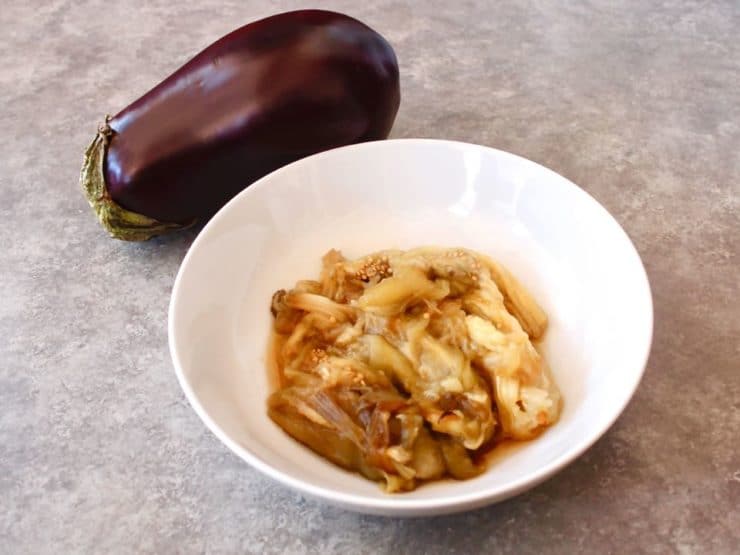
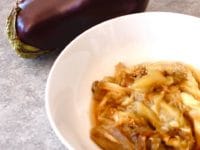
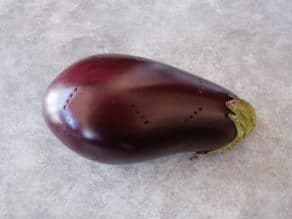
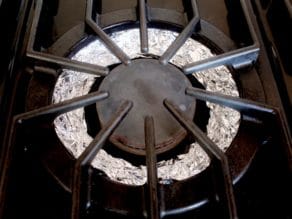
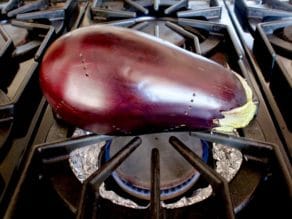
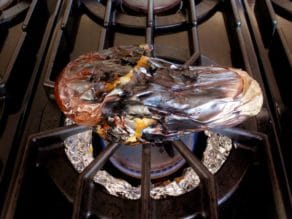
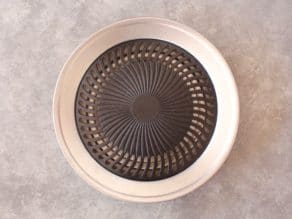
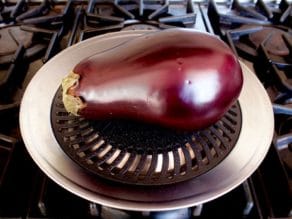
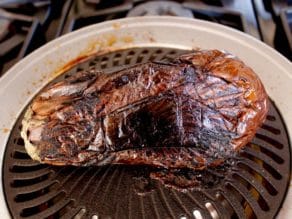
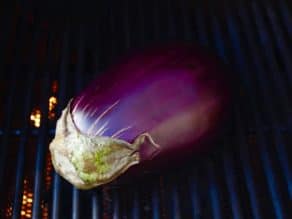
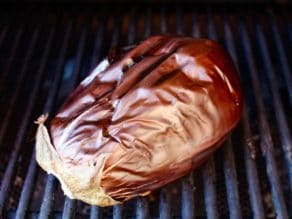
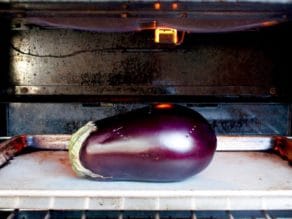
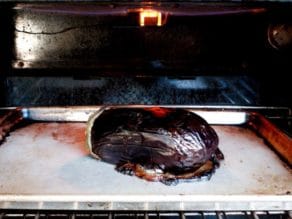
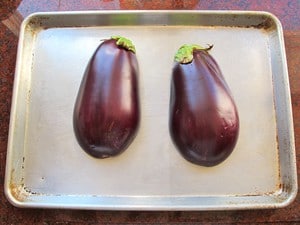

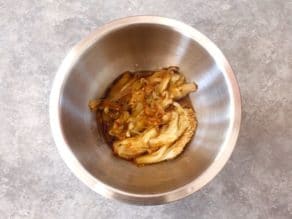
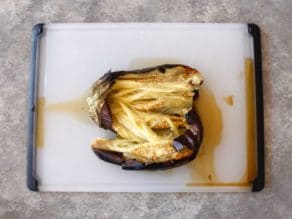
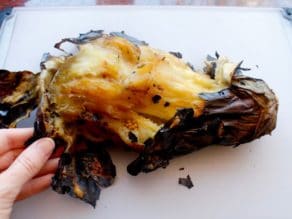


Please advise on how to determine if an eggplant is bitter before it is cooked and eaten.
All eggplants have a little bitterness (that’s part of their characteristic flavor). It tends to dissipate when cooking, particularly when frying. You can taste a little piece of the raw flesh to check if you have come across an extremely bitter one, but it’s rare. Note that if the raw flesh is only a little bitter, this is normal, and salting and cooking it will help to balance out the bitter flavor. If it tastes extremely bitter, you may want to discard it. To avoid bitterness, try buying the freshest eggplant possible (from the farmer’s market is ideal!). Also if there are a lot of seeds, you can discard the seedy parts which tend to hold the most bitter flavor.
Thank you for the useful recipes and pictures
What temp is the oven suppose to be set to? It doesn’t say. :\
These methods require use of the broiler, which does not have a temperature setting – it is called the “Broil” setting on most ovens.
I love babaganosh but have not been able to find it in the area. Finally I found a restaurant that served it and got it to go and it was horrible. I wanted to make it myself so now that I have beena lot of eggplant growing in my garden I have that chance. Thank you.
Tori! This is absolutely amazing! I have never really known what to do with eggplant or how to feel about it. Every time I have made it I would consider the flavor “just okay” but this method of cooking has changed that forever! I used the broiler method to make your recipe for baba ganoush and could have eaten the eggplant by itself! The baba ganoush turned out great as well but I must say I will be eating more eggplant from this day forward!
Wow obviously I am ecstatic. Thank you for the recipe.
Starting with my Father we have been growing Black Beauty Eggplant in our Brooklyn garden for over 50 year. Watching my Mother she cooked the Eggplant on the stove top in a Potato Baker. Turning it until all sides are charred and soft, no stove cleanup. Spooning out and removing any LARGE seed pods to lessen any bitterness. Once it was mashed with a fork, Olive oil, Garlic powder and diced Onion was added. We eat it on sliced Wheat Bread with Mayonnaise and sliced Tomatoes, also from my Brooklyn garden.
I never investigated making baba ghanoush before and didn’t realize how much went into the cooking of the eggplant. I have read the comments and like your method best. Seems wasteful to discard 11 pounds of salt after making one eggplant. I have tried and do love the dish. I think my electric oven will get a workout with the broiler soon, once the heat of the season evolves into cooler fall weather.
Thanks for posting this! Excellent for Turkish recipes
Thank you so much! i will try your methods and see how they work. My last attempt failed, my eggplants became dry in the oven and despite i cooked it for more than a 1.5 hours they stayed hard. I think it happened because i made to many holes with a fork and all the juices flashed out.
Easiest method of cooking eggplant right (not saturated with oil) that I’ve found so far. Currently I’m using it as a filling for eggplant lazagna. I’ll try the ganoush next time.
Interesting recipe/method, and one that I will try. Although I’m not (yet) a Jew, I do plan to convert and will most likely be adopting Sephardi minhagim, so you recipe blog is a real help as I’m already trying to follow kashrut.
One variation necessary is that, in Australia, most stoves, whether gas or electric, have a separate compartment for the griller (we call it a griller and grill our food, whereas in he USA it’s a broiler and you broil the food. Broil has a quite different meaning here). Thank G-d that you include pictures as I now know that I need to put the eggplant , as we here would say, “under the griller”.
Thank goodness I found your comment. I thought the same thing and glad your comment clarified it for me.
I am trying to roast a couple of fairly large aubergines in a toaster oven – over 2hrs now and still not smushy 🙁 Am growing to loathe my toaster oven but renting an apartment in China and not many other oven options.
I have successfully tested another alternative. Although there is a gas stove where I live, it’s a shared house and my roommates would kill me if I roasted an eggplant on an open flame. We don’t have a grill, the stove is very old and wrecked, and its oven is not operational. But I was determined to make baba ganoush and I had an idea.
You may have heard of the millenia-old Chinese technique of cooking in salt – yes, actual pure dry salt powder, lots of it! The Chinese typically roast a whole chicken in salt, but the same technique can be used to cook or roast just about anything. Salt doesn’t melt at ordinary cooking temperatures, it doesn’t burn, and it conducts heat very well, so a large mass of heated salt can almost mimic an oven. This method is also very much energy-efficient.
Actually, this method is particularly good for beef, because the salt absorbs the steam as the meat is heated, and that forms a hard, impermeable crust that seals the rest of the moisture inside. This makes even cheap, harder beef cuts tender and moist.
This method only works for large chunks of food and not for chopped bits, as the latter would obviously become too salty, but if the pieces are large enough (like a whole cut of beef, a chicken or an eggplant), the food doesn’t get salty at all, because the steam pressure pushes the salt out. At most, you may need to wash a few salt grains off the surface afterwards. Actually, after whatever you’re cooking is done, you will need to salt it as usual!
So, I did that with eggplants this time. You will need a large pot with a working lid. The pot should NOT have nonstick (Teflon) coating, as it gets extremely hot, that damages the Teflon and makes it release noxious fluorine fumes. And you will need LOTS of salt – depending on the size of the pot, as much as 5 kg (approximately 11 pounds). It doesn’t need to be coarse salt or any special type – any kind of salt will do. You only need it as a heat delivery method, it won’t be ingested and it will be discarded in the end anyway.
First take the empty, clean, dry pot, and completely cover the bottom with a generous layer of salt (about 1 kg or 2 pounds just for that!). Then place the eggplants on top. The eggplants need to be WHOLE and undisturbed, not even pierced with a fork as indicated in the article. Then literally bury them in salt until you can’t see them. Place the covered pot on the stove and set it to high.
Large eggplants should be cooked in 30-40 minutes, but you want to leave them there for an hour or longer for the sake of flavor. Some descriptions of the salt method say that it should be good when the salt on top is cracked, but I’ve found that this is not a reliable indicator (regardless of what you’re cooking) – ignore that and consider the time. When cooking eggplants in salt, the dyes from the skin may leach to the salt and make part of it blue, purple, or pink. Don’t panic, that’s normal. After it’s done, you can just discard the salt in the garbage bin (or if cooking meats, perhaps keep some of the “dirty” salt to season something else).
The result was very good with eggplants. I would still recommend the open-flame method if it’s feasible for you, because while the salt method does impart a characteristic flavor, it’s very mild and not really smoky as some recipes (particularly baba ganoush) require. If making baba ganoush after using the salt method, I’d recommend that you keep some of the skin to enhance the flavor. But for people with limited heating options in their kitchen, this method is much better than using the microwave or giving up the recipe altogether. Note that this could be done even over a campfire.
Thank you so much for this comment! I didn’t know this cooking method and now I’m dying to try it with beef 🙂
Thanks Tory, You are wonderful, I learnt a lot from you, the recipes. I am sure my wife, children, family and friends will love it. Thank you so much. Your taste is excellent. I grow eggplants my own.
Hi David, thanks. There is still some debate in the scientific community about this issue, however I have cut back dramatically on my use of foil through the past couple of years as a precaution. This is an older post on my site. Now I generally flame-roast it without the foil. It is messier and the stovetop cleanup is a pain, but it gives a brilliant smoky flavor due to the burned skin and no fear of leaching. You can also use the grill if you prefer, no foil required.
I just tried it on top of my gas stove. Worked like a charm. I’ll be using it in my vegan stuffed dolmades recipe..Thanks for this easy tip!
East Indian Dish from eggplant is made from roasted Eggplant. The roast is flavourfull if done in open charcoal fire- it otherwise woks too.
After roast remove skin and temper in oil and mustered seeds and add salt, garlick, lemonn juice and a pinch of sugar and termerick. If you like fresh chillies just a little bit.
You can enjoy this with Chappatis , rice or any other dish.
For a shortcut you can roast( just cook) egg plant in micro wave covered in a glass dish.
I came here looking for information about how to roast an eggplant without oil and found it. Now I’m even more inspired to try this out. Thanks for the info!
I recently visited Romania, and they have a delicious dish called zacusca, made with roasted eggplants, roasted peppers, onions and tomato paste. They traditionally eat it cold on bread as a snack or side dish. I made a batch last weekend, roasting the eggplants and peppers over charcoal. I thought I would need the skin to char over the heat to get a good roasted flavor, as that is how they do it in Romania. I plan to make it again, and was looking for better ways to roast the eggplant which brought me to your blog! 🙂
By the way, my first try at zacusca was a great success! I plan to try using it as a sauce for zuchinni “noodles” and maybe an eggplant lasagna.
In India , we make it as a side dish with a special stuffed bread ! Very rich in flavor . I mash the roasted eggplant with roasted tomatoes and then add chopped garlic n onion , salt , green chili n chopped cilantro and a dash of mustard oil ! You can also add some roasted or boiled potatoes to it . It tastes awesome !!